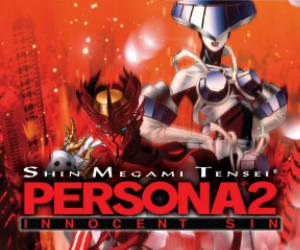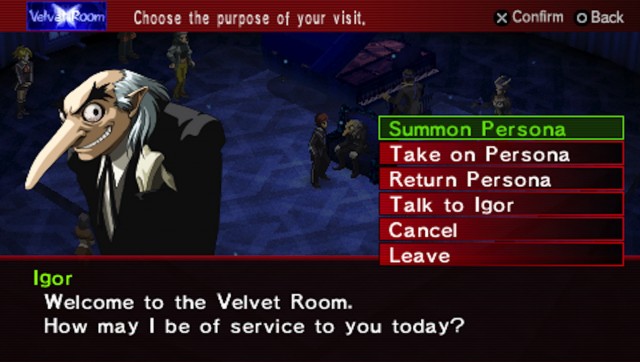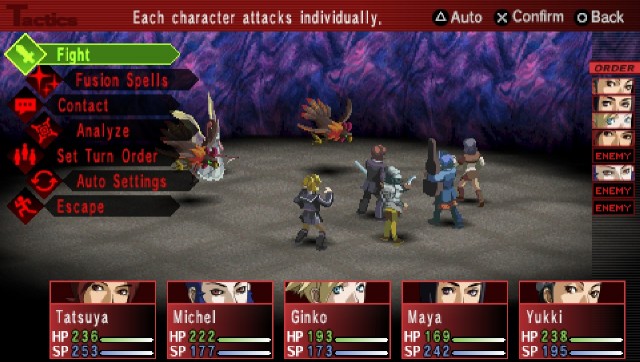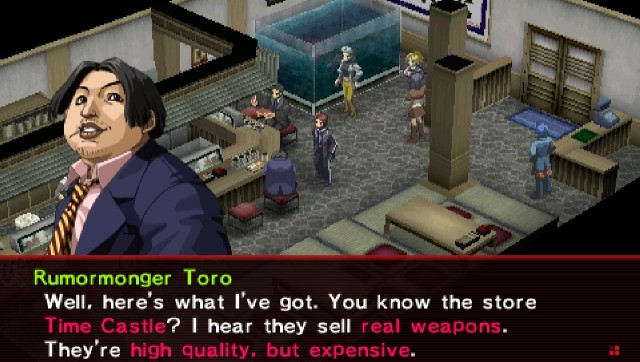Persona 2: Innocent Sin Review
 Game: Persona 2: Innocent Sin
Game: Persona 2: Innocent Sin
Developer: Atlus
Publisher: Ghostlight
Available on: PSP
Were it not for the giant magical monsters, the premise of the Shin Megami Tensei: Persona series sounds a lot like the plot of a John Hughes movie. A mis-matched set of teenage protagonists, thrown together through circumstance, come to learn that the greatest power they possess is inside them, if they only have the courage to harness it. The aforementioned monsters, or “Personas”, are the physical manifestations of that power, and it’s only by developing their personalities and relationships that our heroes can strengthen their Personas and conquer the dark forces that threaten their world.
It’s a pleasing metaphor, and one that it’s a wonder fewer games take the trouble to exploit. By moving the battleground inside the mind, the Shin Megami Tensei: Persona series of JRPGs makes its characters’ struggles all the more relateable, some feat when you consider that those struggles often involve slaying greased-up fairies. Heavy on philosophy and light on science, the series should appeal to those who enjoy the uncomfortable psychological probing of Silent Hill but wish it contained more pop music and menu screens.
Innocent Sin is pretty much the second game in this series. I say “pretty much” because it has a twin, Eternal Punishment, which takes place in a parallel universe where the events of Innocent Sin did not occur. The game is preceded by Revelations: Persona, with which it shares a few characters, and succeeded by Personas 3 and 4, to which it has no narrative connection.
If you don’t like JRPGs, it’s probably best to stop reading now. Despite a real-world setting and its focus on relationships, Innocent Sin is at heart a stat-heavy, turn-based, pointy-haired Japanese roleplaying extravaganza, and no matter how much you’re intrigued by the story, there’s no escaping the grinding, menu-fiddling and pressing-X-to-attack you will have to do to unravel it.
Still, its worth pointing out the ways in which Innocent Sin stands out from its generic bretheren. There’s the fact that you are encouraged to talk to your enemies before (or instead of) destroying them, but we’ll get to that later. Most exciting for the part-time JRPG apologist is the story. Shunning the well-trodden pastel coloured path of its forbears, in which a party undertake an epic quest through spectacular fantasy environments in order to bring down a monstrous corporation/empire/beast, Innocent Sin takes place almost entirely in an urban setting rendered in a moody palette of cobalt blue and gunmetal grey that reflects our heroes’ youthful malaise and abstract struggles. Ahem.
Among these abstract struggles are the disfiguring ailment that has been engulfing students from the prestigious Seven Sisters High, the fact that outrageous rumours seem to be coming true, and the terrifying reality of the Joker game, in which students call themselves on their cell-phones in order to confess their dreams, only to find that “Joker” himself turns up, whereupon he either makes those dreams come true or removes them altogether, leaving a mindless forgotten husk where once there was an wistful teen in a sailor suit.
Our brooding hero, Tatsuya, finds himself tasked with getting to the bottom of these various issues, so it’s just as well he happens to be a Persona user, one capable of summoning the powerful protective creatures to fight demons for him. The rest of the central party are Persona users too, and between them they offer the potential for varied and interesting combat, especially when you consider that individual Personas can level up and learn new abilities, as well as their wielders.
But I’m getting ahead of myself. Persona 2: Innocent Sin’s USP, and the source of almost all of its charm is the fact that not only can you beat demons into a squealing technicolor pulp, you can talk to them too.
Yes, almost every enemy you encounter, with the exception of some bosses and brain-dead zombies, can be “contacted” before battle, with the aim of befriending them, or amusing them into giving you tarot cards (of which more later), items or money. Though you’ll need to fight plenty in order to level up (and fear not, many demons are grumpy littel critters who are tooth-gnashingly hard to placate), contacting demons should be your first action, both because the rewards are worthwhile, and the process is so entertaining.
Every member of the party has several unique conversation starters. Among them are self-proclaimed Caucasian hottie Lisa’s ability to “seduce” weak-willed demons, TV star Maya’s “interview” technique, which appeals to the egotistical, and Tatsuya’s amusingly-titled “discuss manliness” opener. Getting it right will result in rewards or even a pact, but scaring demons off will leave you empty handed, and angering them will result in a fight.
Half the fun of Persona 2 is figuring out what approach will work for each demon. You might imagine that a pink fairy will want to “discuss love” with Lisa, but she could work out she’s being manipulated and get angry. Likewise, a demon with low self-esteem might respond well to being “reprimanded” by tough girl Yukki, but if she gives the wrong answer to a psychological question (“So, foolish human, would you rather take the direct but difficult path, the meandering but easy one or the dark, mysterious one?”), he’ll get disillusioned and attack.
Although there’s a certain amount of trial-and error involved in succeeding at these conversations, both in selecting the correct character and line of approach, for the most part they have a pleasing logic to them. Demons you’ve met before have their personality traits displayed to you, which helps you figure out if its worth trying to outwit them, or whether you should just be honest.
The icing on the conversational cake is your ability to select up to three members of your party to approach the demon together. The characters’ relationship is summarised before you send them in, so you can guess the probable outcome before you commit yourself. This is a really nice way of tying character and story in with core gameplay, something JRPGs can sometimes struggle to do.
The battle system that you’ll experience every time you “lose” a converstion is not overly complex, but it’s streamlined, logical, and gets progressively more interesting the more Personas and ablities you unlock. You acquire new Personas by collecting tarot cards and visiting The Velvet Room, a staple in all Persona games, and exchanging the cards for Personas with Igor, the mysterious hook-nosed gentleman who resides within. The Personas you can summon depend on your character’s level and the “Arcanca” of the tarot cards you have in your possession (“Devil”, “Lovers”, “Chariot” etc), and only one can be equipped at any one time. However, that one develops as you fight demons, and can be taught new abilities with spare cards.
Outside battle, there’s a fairly large urban playground to explore, populated by a large number of NPCs with nothing better to do than pass on the vital rumours you’ll need to unearth black market sources of weapons and armour. It’s nicely designed, but the more time you spend in it, the more you’ll realise how little you have to do with it. You see, unlike later entries in the series, Persona 4 in particular, Innocent Sin never quite makes you feel like you’re part of the community you’re trying to save.
In a game which relies on relationships to give it an emotional impact, this creates a niggle that some players will struggle to overcome. There’s great emphasis placed on Tatsuya & Co belonging to Seven Sister’s High, but you only spend time there if you’re fighting off demons. It’s clear that Atlus learned from this, since Personas 3 and 4 have you attending class, joining clubs and building meaningful friendships with peripheral characters, but the absence of such features in Innocent Sin leaves the world feeling slightly sterile.
Some players may also find themselves alienated by references to Revelations: Persona, both verbally, by returning characters, and insinuated by an idiosyncratic world that wastes no time getting you up to speed. Indeed, new players may feel rather lost for the first few hours of gameplay, rather like someone who has arrived late to class and not completed the required reading.
Still, the story’s arguably intriguing enough to make up for its lack of emotional pull, and the characters grow more endearing the longer you spend with them. And while the narrative’s pacing might be a little stop-start at times, it contains enough twists to keep you interested. It’s also hard to argue with a game so full of content: alongside the compulsory JRPG longevity, there are many interesting sidequests to keep you entertained. The iffily-named “Climax Theatre” in particular offers standalone missions that have you solving minor mysteries as a refreshing break from what can become a slightly bewildering main storyline.
VERDICT: Persona 2: Innocent Sin is an interesting prospect, both for fans of the series and curious gamers who are ready to wander off the beaten track of swords, moogles and mana bars. It’s not as good as the series’ later installments, and there’s even an argument for avoiding it altogether until after completion of (the bizarrely first-person) Revelations: Persona, also available on PSP. But it’s still a thought-provoking, unique, and thoroughly entertaining JRPG, one that fans of the genre should seriously consider playing.
If only to find out what happens if you try to seduce a minotaur.








